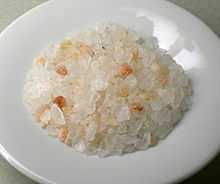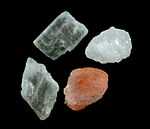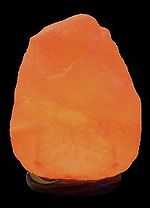Himalayan salt

Himalayan salt is a marketing term for halite (commonly known as rock salt) from Pakistan, which began being sold by various companies in Europe, North America, and Australia in the early 21st century. It is mined in the Khewra Salt Mines, the second largest salt mine in the world, located in Khewra, Jhelum District, Punjab, Pakistan, about 300 km from the Himalayas, about 160 kilometres from Islamabad, and 260 kilometres from Lahore, and in the foothills of the Salt Range. The salt sometimes comes out in a reddish or pink color, with some crystals having an off-white to transparent color.
Mineral composition

In 2003 the Bavarian consumer protection agency Bayerisches Landesamt für Gesundheit und Lebensmittelsicherheit analyzed 15 specimens of Himalaya salt sold in Germany and could detect at least ten different minerals, in addition to sodium chloride (98%). The agency stated that the salts come from Pakistan and can, like all salts, cause hypertension (high blood pressure) if over used.[1]
The chemical composition of Himalayan salt includes 95–96% sodium chloride, contaminated with 2–3% polyhalite and small amounts of ten other minerals. The pink color is due to iron oxide.[2][3]
Uses
It is commonly used in cooking, in place of other table salt, in brine, and for bath products such as bath salts.[4] Blocks of salt are also used as serving dishes and in the preparation of food. Fish and some meats can be preserved for use in certain dishes, and blocks of salt can be slowly heated to a temperature of around 400 degrees Fahrenheit and used as a cooking surface thereafter.
Salt lamps

Large crystal rocks are also used as salt lamps. A salt lamp is a lamp carved from a larger salt crystal, often colored, with an incandescent bulb or a candle inside. The lamps give an attractive glow and are suitable for use as nightlights or for ambient mood lighting. Mined in Europe and Asia, when illuminated, salt crystals emit a soft glowing light and are hand-carved. Some believe that heated salt crystals emit negative ions or positive energy waves into the air.[5] There is, however, no scientific evidence that salt lamps actually give out a measurable amount of "negative ions", nor is there any evidence of any health benefits from the lamps.[6]
See also
References
- ↑ Alles nur Kochsalz - LGL nimmt 'Himalayasalz' genauer unter die Lupe Bayerisches Landesamt für Gesundheit und Lebensmittelsicherheit. 11. August 2003
- ↑ Bitterman, Mark (25 August 2010). "Chemical Analysis of Natural Himalayan Pink Rock Salt". Salt News. Retrieved 18 December 2013.
- ↑ "Himalayan Pink Salt". Mountain Rose Herbs. Retrieved 18 December 2013.
- ↑ "Himalayan Bath Salts – True Health Benefits or Marketing Hype?". OrganicSkinHerbsOnline.com. 13 October 2013. Retrieved 18 December 2013.
- ↑ Neil Nedley, Depression: The Way Out (Ardmore, OK: Nedley Publishing, 2002)
- ↑ Lisa Berger. "Salt Lamps - Is it a Scam?". Today in Alternative Medicine. Retrieved 2012-10-23.